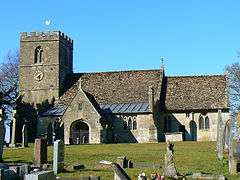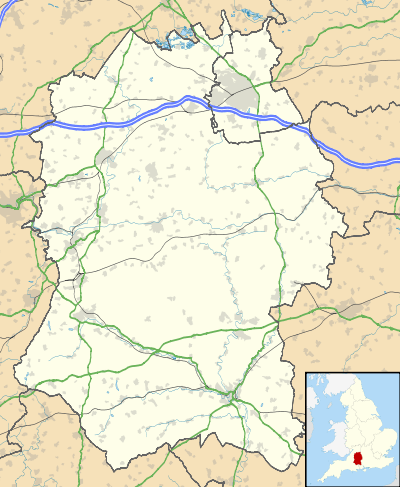Chirton
Chirton is a village and civil parish in Wiltshire, England, on the southern edge of the Vale of Pewsey about 5 miles (8 km) southeast of Devizes. The parish includes the hamlet of Conock.
| Chirton | |
|---|---|
 The church of St John the Baptist, Chirton | |
 Chirton Location within Wiltshire | |
| Population | 406 (in 2011)[1] |
| OS grid reference | SU073575 |
| Civil parish |
|
| Unitary authority | |
| Ceremonial county | |
| Region | |
| Country | England |
| Sovereign state | United Kingdom |
| Post town | Devizes |
| Postcode district | SN10 |
| Dialling code | 01380 |
| Police | Wiltshire |
| Fire | Dorset and Wiltshire |
| Ambulance | South Western |
| UK Parliament | |
| Website | Parish Council |
The settlements are just off the A342 Devizes-Andover road. To the south the parish extends onto Salisbury Plain.
History
Chirton (17 households)[2] and Conock (18)[3] were recorded in the Domesday Book of 1086. At that time Conock was held by Grestain Abbey, Normandy; in 1324 the land was seized by the king, along with other alien priories.[4]
Conock Manor (c. 1700) is Grade II* listed.[5] Pevsner describes it as "a Georgian house of great charm".[6]
The population of the parish peaked around the middle of the 19th century, with 467 recorded at the 1851 census, declining to 261 by 1901.[1]
When the Stert and Westbury Railway was opened through the Vale in 1900, the nearest station was near Patney, 1 mile (1.6 km) north of Chirton village. Known initially as 'Patney Bridge', this was soon changed to 'Patney and Chirton' to avoid confusion with Putney Bridge station in London. The station closed in 1996.
Religious sites
The Church of England parish church of St John the Baptist has Norman features; in the 12th century the church was granted to the newly established Llanthony Secunda priory at Gloucester, and the 12th-century font survives. The tower was added in the 15th century. A severe restoration was carried out in 1850 by William Butterfield.[7] The church was designated as Grade I listed in 1962.[8]
The benefice was united with Marden in 1923, and the vicar was to live at the parsonage house in Chirton.[9] From 1951, the vicar also held the benefice of Patney,[10] which was added to the united benefice in 1963.[11] The three benefices were separated in 1976.[12] Today the church is served by the Cannings and Redhorn Team Ministry, which covers a group of eight churches in the Vale of Pewsey.[13]
Conock had a chapel in the 13th century, which fell into disuse after the land was seized by the king.[4]
Local government
Chirton is a civil parish with an elected parish council, styled as Chirton & Conock Parish Council.[14] It is in the area of Wiltshire Council, a unitary authority responsible for almost all local government functions, and is represented there by Paul Oatway, who succeeded Brigadier Robert Hall in 2013.
Amenities
Chirton has a church of England primary school which serves the nearby villages. Sited near the church, the building began as a National School in the 1840s.[15]
References
- "Wiltshire Community History - Census". Wiltshire Council. Archived from the original on 17 November 2015. Retrieved 13 November 2015.
- Chirton in the Domesday Book
- Conock in the Domesday Book
- "Victoria County History - Wiltshire - Vol 10 pp 60-71 - Parishes: Chirton". British History Online. University of London. Retrieved 14 November 2015.
- Historic England. "Conock Manor (1182202)". National Heritage List for England. Retrieved 14 November 2015.
- Pevsner, Nikolaus; Cherry, Bridget (revision) (1975) [1963]. Wiltshire. The Buildings of England (2nd ed.). Harmondsworth: Penguin Books. p. 173. ISBN 0-14-0710-26-4.
- "Church of St. John the Baptist, Chirton". Wiltshire Community History. Wiltshire Council. Archived from the original on 17 November 2015. Retrieved 14 November 2015.
- Historic England. "Church of St John the Baptist, Chirton (1035807)". National Heritage List for England. Retrieved 14 November 2015.
- "No. 32870". The London Gazette. 12 October 1923. pp. 6860–6861.
- "No. 39156". The London Gazette. 23 February 1951. p. 981.
- "No. 43194". The London Gazette (Supplement). 24 December 1963. p. 10547.
- "No. 46912". The London Gazette. 27 May 1976. p. 7542.
- "Chirton". The Cannings and Redhorn Team. Retrieved 18 September 2018.
- "Chirton Parish Council". Wiltshire Council. Retrieved 14 November 2015.
- "Chirton Church of England Primary School". Wiltshire Community History. Wiltshire Council. Archived from the original on 17 November 2015. Retrieved 14 November 2015.
External links
- Chirton Parish website
- "Chirton". Wiltshire Community History. Wiltshire Council. Archived from the original on 22 October 2015. Retrieved 14 November 2015.
| Wikimedia Commons has media related to Chirton. |